Research on the Evaluation and Optimization of Street Quality in Cultural Attractions Based on Spatial Data
Abstract
1. Introduction
2. Literature Review
3. Methodology
3.1. Weighting
- (1)
- Establishment of a hierarchical structure system model: The hierarchical structure used in this study includes 3 target layers and 10 index-layer elements, as shown in Table 1.
- (2)
- Constructing a rating matrix
- (3)
- Hierarchical single ordering and consistency test
- (4)
- Hierarchical Total Ranking and Consistency Test
3.2. Numerical Calculation of Indicators
3.2.1. Street Natural Environment Perception
- (1)
- Road Visibility Index
- (2)
- Green Visibility Index
- (3)
- Building Visibility Index
- (4)
- Sky Visibility Index
3.2.2. Street Human-Centered Emotion Perception
- (1)
- Environment Beauty Index
- (2)
- Environment Activity Index
3.2.3. Spatial Accessibility of Facilities
- (1)
- Dining Accessibility
- (2)
- Shopping Accessibility
- (3)
- Transport Accessibility
- (4)
- Landscape Accessibility
3.3. Sorting of Scenic Areas
4. Case Study
4.1. Selection of Cultural Scenic Spots
4.2. Calculation of Indicator Weights
4.3. Numerical Calculation of Indicators
- (1)
- Geographical information data sources: This study used road network data applicable to Yanta District, Xi’an, from OpenStreetMap (OSM). To ensure that the data accurately reflected the current road conditions in Yanta District, the original OSM data were corrected, which mainly involved merging the multi-lane road network into single-lane roads to avoid duplication and redundancy in the flow and accessibility analysis.
- (2)
- Natural environmental characteristics: The analysis of natural environmental features was based on data from Baidu Street View, focusing on the roads in Yanta District. Semantic segmentation was performed using a fully convolutional network (FCN) to extract natural elements such as green areas and water bodies from the street view images and calculate their percentage in the visual scene to quantify the green visual coverage of the streets in Yanta District and other natural environmental indicators.
- (3)
- Human-oriented perception data: The acquisition of human perception data was based on images from Baidu Street View combined with the City Six perception pre-processing model, which uses questionnaire scoring, convolutional neural networks (CNNs), and human–computer adversarial models to calculate the environmental aesthetic index and community vitality index of the streets of Yanta District. This method integrates subjective and objective analysis and aims to comprehensively evaluate the humanistic emotional characteristics of the streets in Yanta District.
4.4. Ranking of Scenic Areas
5. Analysis of High-Potential Scenic Areas
5.1. Sui Daxing Tang Chang’an City Mingde Gate Ruins Park
5.2. Temple of Heaven Ruins Park
5.3. Xi’an Municipal Museum
- (1)
- Increase green visual cover. In Sui Daxing Tang Chang’an City Mingde Gate Ruins Park and Temple of Heaven Ruins Park, which already boast a high green visual coverage, further selection of tree species such as ginkgo trees and cherry trees can enhance their visual effect and environmental benefits. For Xi’an Municipal Museum, which may have areas with lower green visual coverage, the green areas on both sides of the roads and within the park should be increased to ensure visual coherence and comfort.
- (2)
- Optimize sky views. In the design and planning of any new facilities, building heights and layouts should be strictly controlled to avoid blocking important historical vistas. In Temple of Heaven Ruins Park and Xi’an Municipal Museum, the openness of views should be enhanced by removing or redesigning structures that obstruct views.
- (3)
- Increase road space efficiency. In Temple of Heaven Ruins Park, where road space efficiency is high, roads should continue to be rationally designed and maintained to ensure tourists have ample space for activities and photography. For Sui Daxing Tang Chang’an City, Mingde Gate Ruins Park, and Xi’an Municipal Museum, where road space might be less efficient, improvements can be made by widening roads, providing spacious sidewalks and bicycle paths, and increasing the number of public rest areas.
- (4)
- Moderate architectural concentration. For Sui Daxing Tang Chang’an City Mingde Gate Ruins Park and Temple of Heaven Ruins Park, building density and style can be adjusted to optimize architectural concentration. Moderate building concentration can provide rich visual elements and enhance the overall aesthetics of these scenic spots.
6. Discussion and Conclusions
- (1)
- This study focuses mainly on evaluation from the perspective of the street, ignoring important dimensions such as cultural attributes, energy level, and the size of the scenic spots. To assess the development potential of cultural sites more comprehensively, future studies will seek to incorporate these factors into the evaluation system.
- (2)
- When setting buffer zones, to more accurately reflect the actual influence and attractiveness of different scenic spots, a more flexible and dynamic buffer zone setting method will be considered in future studies. For example, different buffer zone radii can be set for each scenic spot based on factors such as its popularity, number of tourists, and historical value to assess its spatial influence and development potential more comprehensively.
- (3)
- Analysis of climatic factors, especially bioclimatic characteristics, could be included in future studies, such as quantitative assessment of microclimate characteristics under different combinations of street widths and building heights, as well as the moderating effect of different ground materials on the microclimate of streets and how they affect the urban microclimate of historic districts. Improving the microclimate of the streets will enhance the comfort of visitors while preserving the unique features and cultural values of the historic districts.
- (4)
- Subsequently, future studies can attempt to introduce more advanced technologies and data sources, such as drone images, IoT sensor data, etc., to improve the accuracy and real-time nature of the evaluation indices. In addition, the combination of virtual reality (VR) and augmented reality (AR) technologies can be considered to provide a more intuitive and immersive evaluation experience. Specifically, drone imaging technology has been used to rapidly extract key information such as vegetation cover and landscape features, enabling immediate updates and the dynamic monitoring of assessment indicators. IoT sensors are widely used to ensure the timeliness and accuracy of data.
Author Contributions
Funding
Informed Consent Statement
Data Availability Statement
Conflicts of Interest
References
- Jinghuan, N.; Zhen, W. Research on function optimization design of public products in Tourist Attractions Based on AHP. In Proceedings of the 2020 13th International Conference on Intelligent Computation Technology and Automation (ICICTA), Xi’an, China, 24–25 October 2020; pp. 173–177. [Google Scholar]
- Jiang, Y.; Huang, W.; Xiong, X.; Shu, B.; Yang, J.; Li, M.; Cui, X. Investigating spatial patterns and determinants of tourist attractions utilizing POI data: A case study of Hubei Province, China. Heliyon 2024, 10, e32370. [Google Scholar] [CrossRef] [PubMed]
- Park, J.; Jeong, E. Service quality in tourism: A systematic literature review and keyword network analysis. Sustainability 2019, 11, 3665. [Google Scholar] [CrossRef]
- Revida, E.; Siahaan, A.Y.; Purba, S. The Influence of Community Behaviour on the Quality of Tourism Services at Toba Lake North Sumatera. Int. J. Res. Bus. Soc. Sci. 2018, 7, 22–29. [Google Scholar] [CrossRef]
- Lin, Y.; Chen, Z.; Xie, J.; Ye, P.; Lan, Z.; Ding, Z. Mechanism of Tourist Landscape Suitability in Natural Historical Heritage Sites: An Empirical Analysis in Quanzhou, China Based on Multi-Source Data and Machine Learning. Available online: https://ssrn.com/abstract=4846037 (accessed on 28 May 2024).
- Xu, J.; Wang, J.; Zuo, X.; Han, X. Spatial quality optimization analysis of streets in historical urban areas based on street view perception and multisource data. J. Urban Plan Dev. 2024, 150, 05024036. [Google Scholar] [CrossRef]
- Li, Q.; Lv, S.; Cui, J.; Zhang, J.; Liu, Y. Environmental Perception about Pedestrian Environment on Cultural Visitation Roads. Sustainability 2024, 16, 7097. [Google Scholar] [CrossRef]
- Wu, Z.; Wang, Y.; Gan, W.; Zou, Y.; Dong, W.; Zhou, S.; Wang, M. A survey of the landscape visibility analysis tools and technical improvements. Int. J. Environ. Res. Public Health 2023, 20, 1788. [Google Scholar] [CrossRef]
- Hernawati, E.; Sari, S.K.; Wijaya, D.R. Combination of Analytic Hierarchy Process and Simple Additive Weighting for Tourist Attractions Recommendation System. Int. J. Appl. Inf. Technol. 2021, 5, 123–131. [Google Scholar]
- Zhang, S.; Lin, J.; Feng, Z.; Wu, Y.; Zhao, Q.; Liu, S.; Ren, Y.; Li, H. Construction of cultural heritage evaluation system and personalized cultural tourism path decision model: An international historical and cultural city. J. Urban Manag. 2023, 12, 96–111. [Google Scholar] [CrossRef]
- Hao, W.; Huaiyue, L.; Dan, L. Research on Spatial Optimization Level Strategy of Beijing Historical Blocks Based on Tourists’ Cognitive Evaluation. J. Landsc. Res. 2022, 14, 14–20. [Google Scholar]
- Gu, X.; Hunt, C.A.; Jia, X.; Niu, L. Evaluating nature-based tourism destination attractiveness with a Fuzzy-AHP approach. Sustainability 2022, 14, 7584. [Google Scholar] [CrossRef]
- Bire, C.; Kasse, D.; Bire, R. Decision support system for selecting tourist attractions using fuzzy analytic hierarchy process. Bull. Electr. Eng. Inform. 2021, 10, 1252–1261. [Google Scholar] [CrossRef]
- Liu, S.; Ge, J.; Bai, M.; Yao, M.; Zhu, Z. Uncovering the factors influencing the vitality of traditional villages using POI (point of interest) data: A study of 148 villages in Lishui, China. Herit. Sci. 2023, 11, 123. [Google Scholar] [CrossRef]
- Jamal Mahdi, A.; Esztergár-Kiss, D. Prioritizing Influential Factors on Tourist Decision-Making for Choosing Destinations Using Parsimonious Analytical Hierarchy Process (PAHP). Tour. Plan. Dev. 2024, 21, 330–353. [Google Scholar] [CrossRef]
- Gil, E.; Ahn, Y.; Kwon, Y. Tourist attraction and points of interest (POIs) using search engine data: Case of Seoul. Sustainability 2020, 12, 7060. [Google Scholar] [CrossRef]
- Liu, R.; Neisch, P. Measuring the effectiveness of street renewal design: Insights from visual preference surveys, deep-learning technology, and eye-tracking simulation software. Landsc. Urban Plan. 2025, 256, 105291. [Google Scholar] [CrossRef]
- Zhang, L.; Ye, Y.; Zeng, W.; Chiaradia, A. A systematic measurement of street quality through multi-sourced urban data: A human-oriented analysis. Int. J. Environ. Res. Public Health 2019, 16, 1782. [Google Scholar] [CrossRef]
- Hu, F.; Liu, W.; Lu, J.; Song, C.; Meng, Y.; Wang, J.; Xing, H. Urban function as a new perspective for adaptive street quality assessment. Sustainability 2020, 12, 1296. [Google Scholar] [CrossRef]
- Yang, L.; Jin, Q.; Fu, F. Research on Urban Street Network Structure Based on Spatial Syntax and POI Data. Sustainability 2024, 16, 1757. [Google Scholar] [CrossRef]
- Li, N.; Zhang, M. Distribution characteristics and influencing factors of tourist attractions in Tianjin based on POI big data. Environ. Dev. Sustain. 2024, 1–27. [Google Scholar] [CrossRef]
- Liang, W.; Ahmad, Y.; Mohidin, H.H.B. Spatial pattern and influencing factors of tourism based on POI data in Chengdu, China. Environ. Dev. Sustain. 2024, 26, 10127–10143. [Google Scholar] [CrossRef]
- Peng, R.; Gao, W. Spatial distribution pattern and driving mechanism of tourist attractions in Gansu Province based on POI data. PLoS ONE 2023, 18, e0292165. [Google Scholar] [CrossRef] [PubMed]
- Wang, R.; Huang, C.; Ye, Y. Measuring Street Quality: A Human-Centered Exploration Based on Multi-Sourced Data and Classical Urban Design Theories. Buildings 2024, 14, 3332. [Google Scholar] [CrossRef]
- Zhang, L.; Xu, X.; Guo, Y. Comprehensive Evaluation of the Implementation Effect of Commercial Street Quality Improvement Based on AHP-Entropy Weight Method—Taking Hefei Shuanggang Old Street as an Example. Land 2022, 11, 2091. [Google Scholar] [CrossRef]
- Moosivand, J.; Farahani, B.M. Analysing the relationship between urban infrastructure and attracting urban tourists by using TOPSIS and AHP models. Tour. Plan. Dev. 2013, 10, 467–479. [Google Scholar] [CrossRef]
- Bire, R.B.; Conterius, A.L.; Nasar, A. Tourist preference and destination competitiveness using the AHP–TOPSIS hybrid model. In Proceedings of the International Conference on Applied Science and Technology on Social Science (ICAST-SS 2020), Padang, Indonesia, 24–25 October 2020; pp. 43–48. [Google Scholar]
- Wang, Z. Spatial Optimisation and Vitality Enhancement Strategies for Urban Villages with the Intervention of Digital Analytics. Ph.D. Thesis, Politecnico di Torino, Torino, Italy, 2023. [Google Scholar]
- Psyllidis, A.; Gao, S.; Hu, Y.; Kim, E.-K.; McKenzie, G.; Purves, R.; Yuan, M.; Andris, C. Points of Interest (POI): A commentary on the state of the art, challenges, and prospects for the future. Comput. Urban Sci. 2022, 2, 20. [Google Scholar] [CrossRef]
- He, X.; Kozlowski, M.; Ujang, N.B.; Ma, Y. Defining Inner-City Transitional Street Typology Using Point of Interest (PoI) Data in Hillside Cities of China. Sustainability 2024, 16, 4690. [Google Scholar] [CrossRef]
- Wang, Y.; Zhang, H.; Liu, L. Does city construction improve life quality?—Evidence from POI data of China. Int. Rev. Econ. Financ. 2022, 80, 643–653. [Google Scholar] [CrossRef]
- Yue, Y.; Zhuang, Y.; Yeh, A.G.; Xie, J.-Y.; Ma, C.-L.; Li, Q.-Q. Measurements of POI-based mixed use and their relationships with neighbourhood vibrancy. Int. J. Geogr. Inf. Sci. 2017, 31, 658–675. [Google Scholar] [CrossRef]
- Du, Y.; Huang, W. Evaluation of street space quality using streetscape data: Perspective from recreational physical activity of the elderly. ISPRS Int. J. Geo-Inf. 2022, 11, 241. [Google Scholar] [CrossRef]
- Xuan, W.; Zhao, L. Research on correlation between spatial quality of urban streets and pedestrian walking characteristics in china based on street view big data. J. Urban Plan. Dev. 2022, 148, 05022035. [Google Scholar] [CrossRef]
- Wang, M.; He, Y.; Meng, H.; Zhang, Y.; Zhu, B.; Mango, J.; Li, X. Assessing street space quality using street view imagery and function-driven method: The case of Xiamen, China. ISPRS Int. J. Geo-Inf. 2022, 11, 282. [Google Scholar] [CrossRef]
- Li, J.; Li, B.; Shen, Y.; Tang, K. Study on the steady state of the propagation model of consumers’ perceived service quality in the community group-buying. J. Retail. Consum. Serv. 2022, 65, 102882. [Google Scholar] [CrossRef]
- Duan, J.; Liao, J.; Liu, J.; Gao, X.; Shang, A.; Huang, Z. Evaluating the spatial quality of urban living streets: A case study of Hengyang City in Central South China. Sustainability 2023, 15, 10623. [Google Scholar] [CrossRef]
- Li, M.; Pan, J. Assessment of Influence Mechanisms of Built Environment on Street Vitality Using Multisource Spatial Data: A Case Study in Qingdao, China. Sustainability 2023, 15, 1518. [Google Scholar] [CrossRef]
- Wan, T.; Lu, W.; Sun, P. Constructing the quality measurement model of street space and its application in the old town in Wuhan. Front. Public Health 2022, 10, 816317. [Google Scholar] [CrossRef]
- Min, J. A Study on the Spatial Distribution of Tourist Attractions above 3A Level in Hangzhou Based on POI Extraction. In Proceedings of the 2023 International Conference on Blockchain Technology and Applications (ICBTA), Beijing, China, 25–27 August 2023; pp. 60–63. [Google Scholar]
- Wu, J.; Qian, M.; Cao, Y. Research on the influence mechanism and optimisation of urban greenway network use pattern based on multi-source data—A case study of Guangzhou, China. In Proceedings of the Fábos Conference on Landscape and Greenway Planning, Budapest, Hungary, 30 June–3 July 2022. [Google Scholar]
- Yu, B.; Sun, W.; Wu, J. Analysis of Spatiotemporal Characteristics and Recreational Attraction for POS in Urban Communities: A Case Study of Shanghai. Sustainability 2022, 14, 1460. [Google Scholar] [CrossRef]
- Mahdi, A.; Esztergár-Kiss, D. Modelling the Accommodation Preferences of Tourists by Combining Fuzzy-AHP and GIS Methods. J. Adv. Transp. 2021, 2021, 9913513. [Google Scholar] [CrossRef]
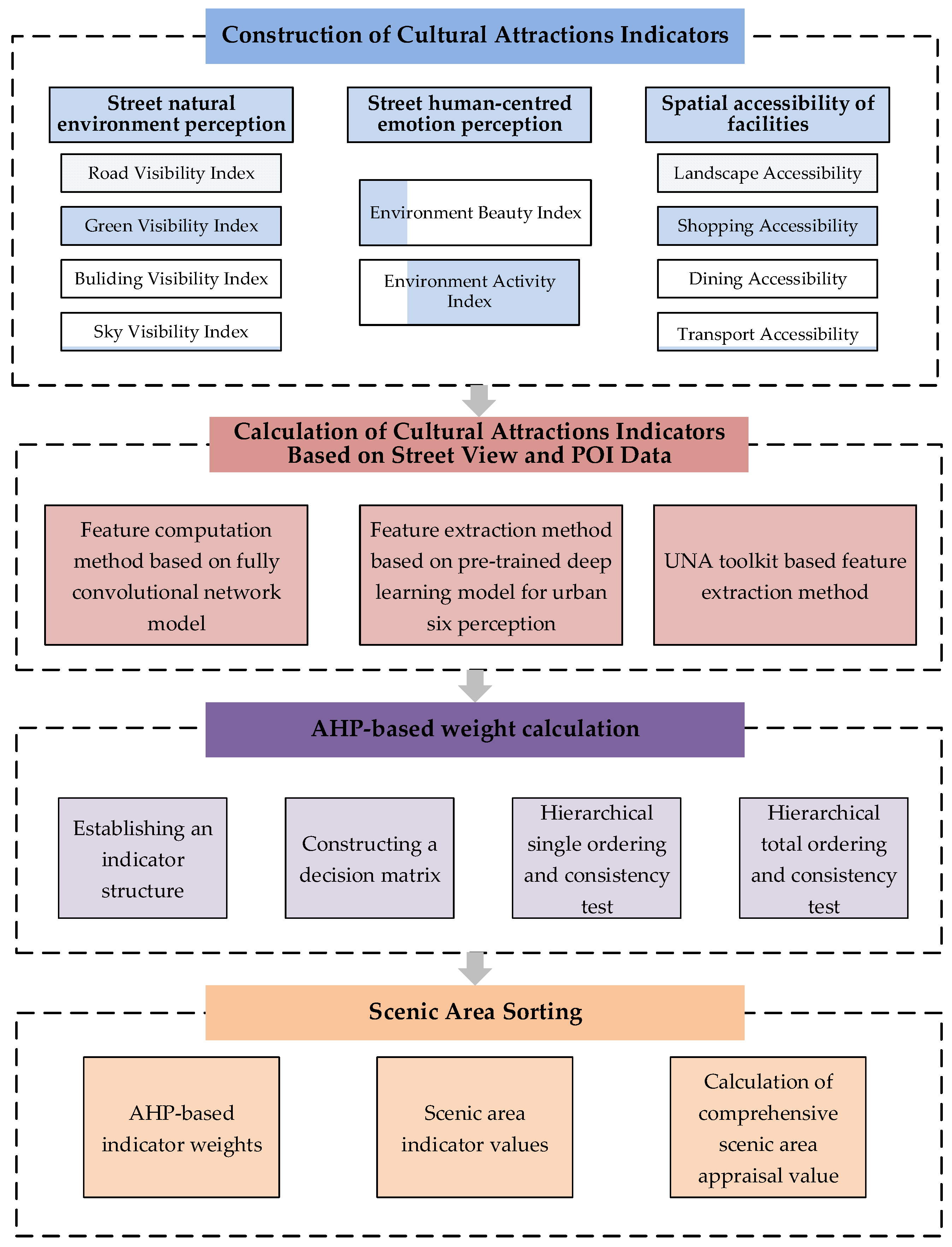

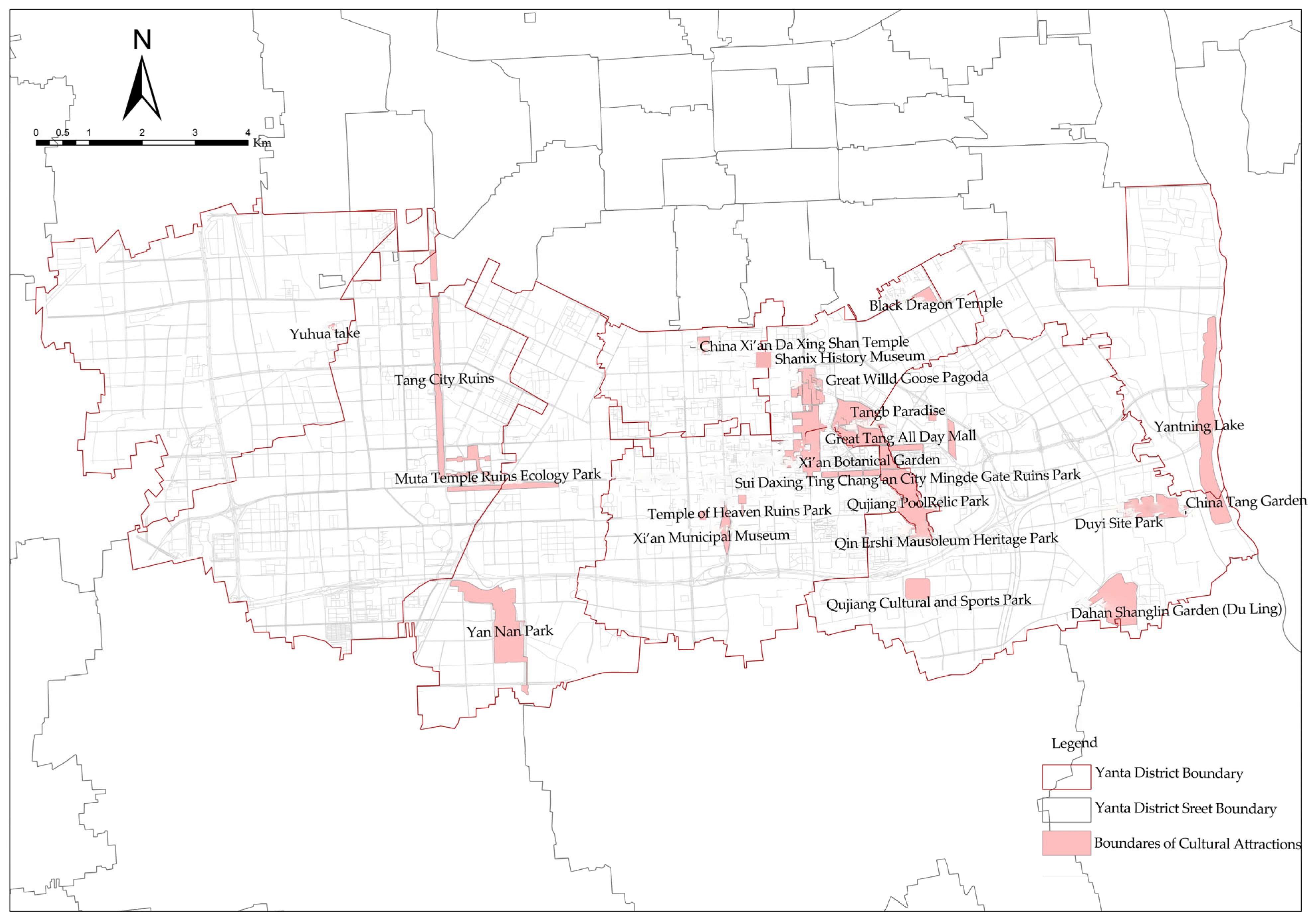
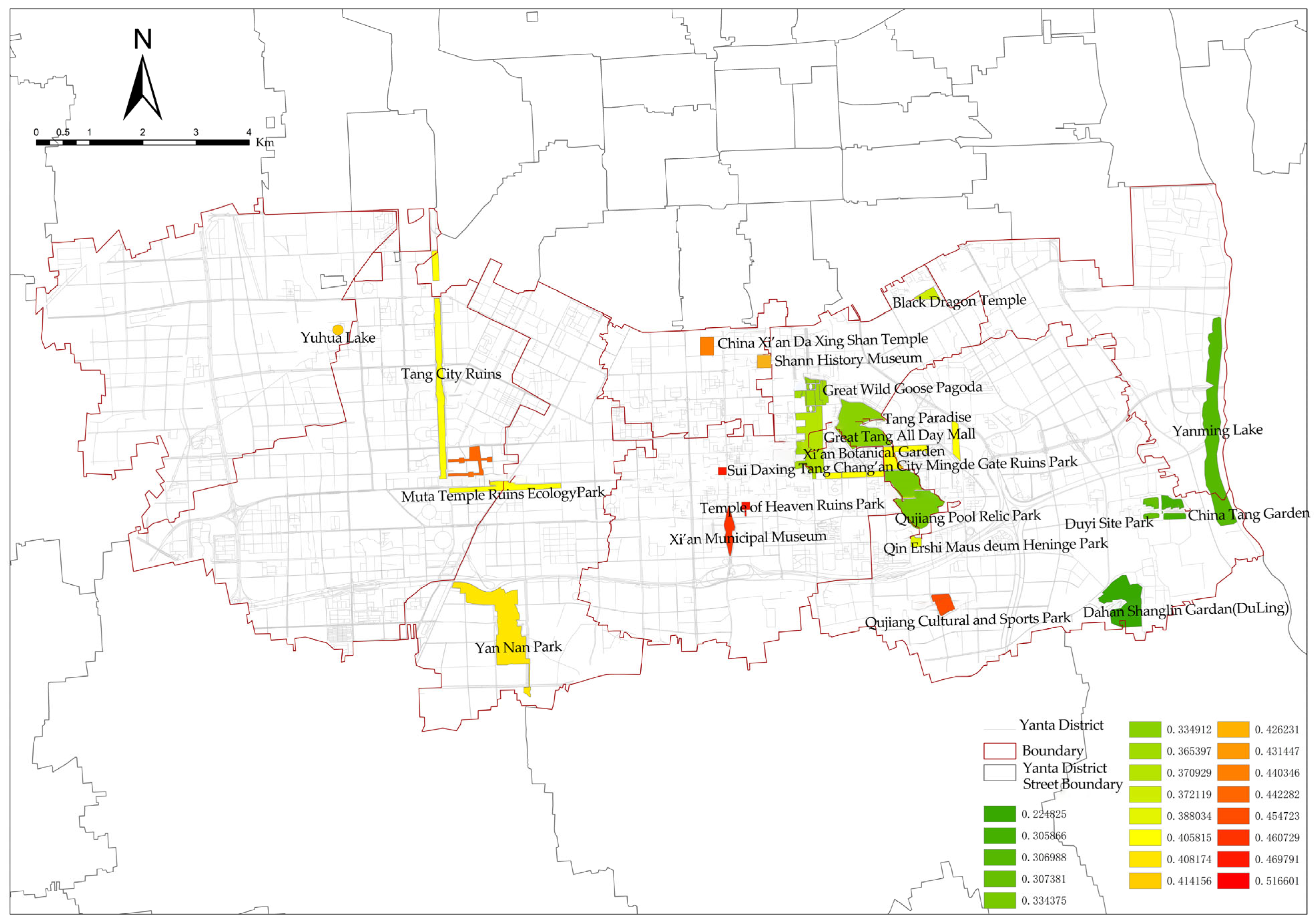

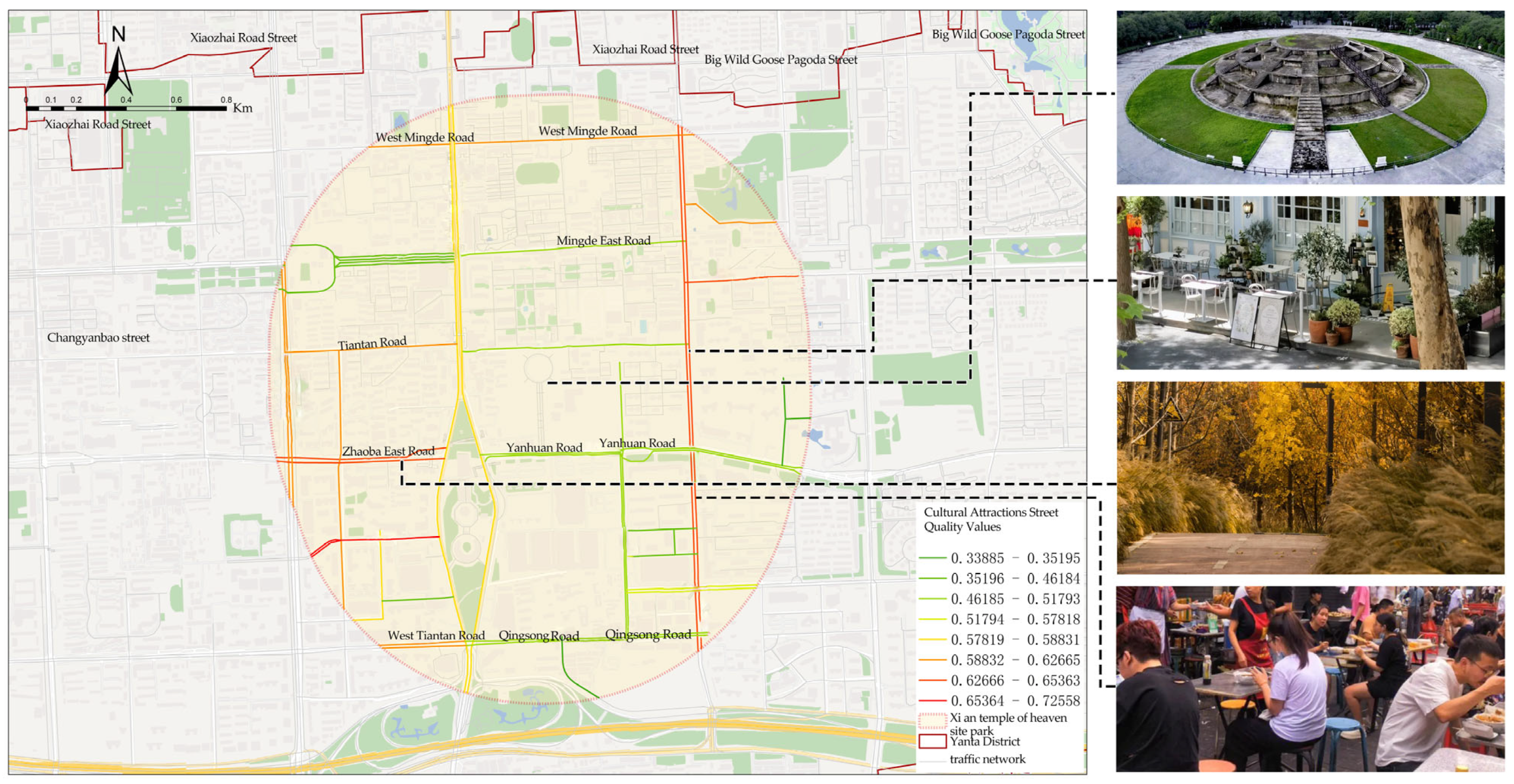
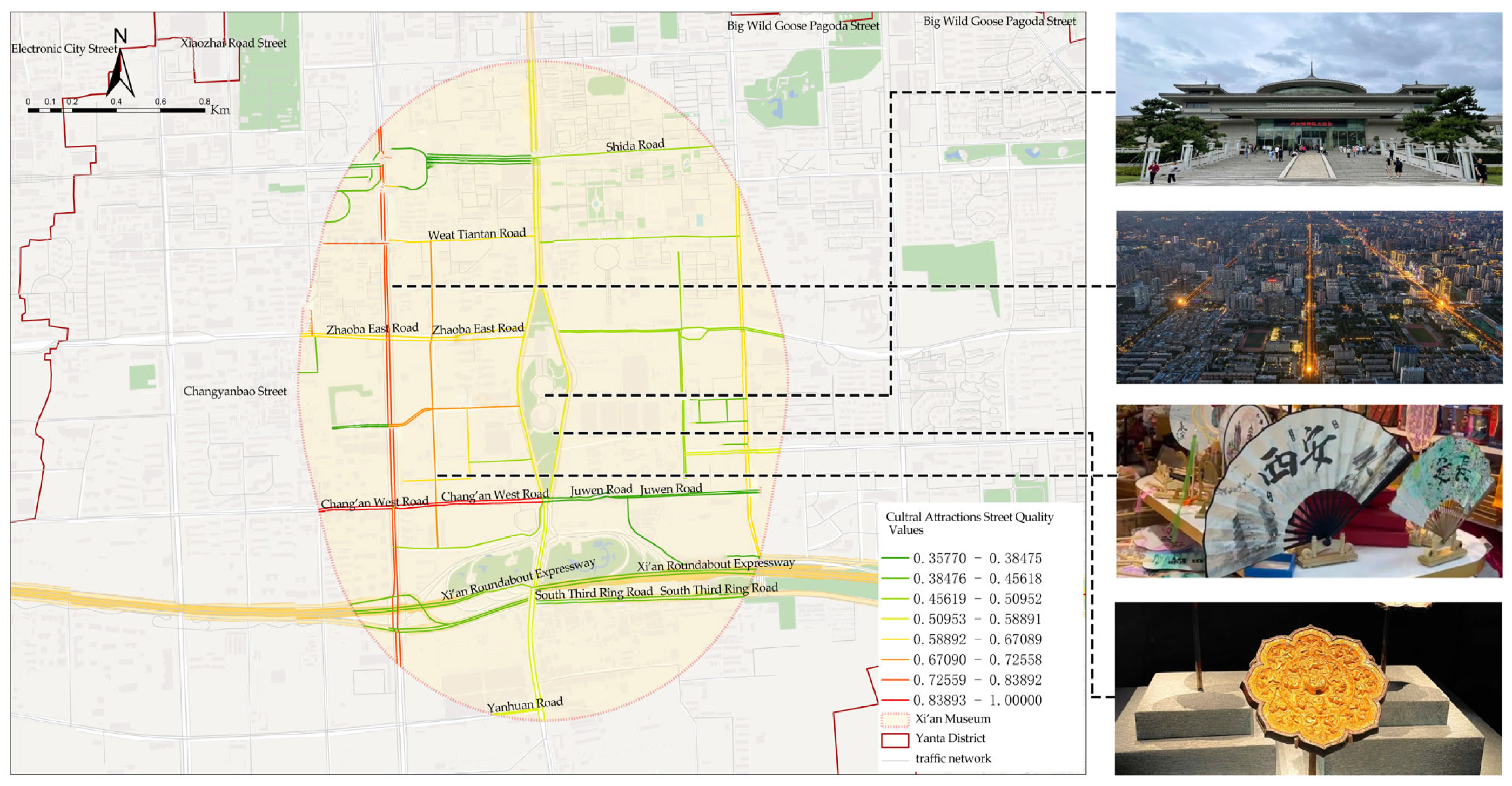
| Target-Layer Elements | Display-Layer Elements |
|---|---|
| Natural Environment Perception | Road Visibility Index |
| Green Visibility Index | |
| Building Visibility Index | |
| Sky Visibility Index | |
| Humanistic Emotional Perception | Environment Beauty Index |
| Environment Activity Index | |
| Spatial accessibility | Landscape Accessibility |
| Shopping Accessibility | |
| Dining Accessibility | |
| Transport Accessibility |
| Meaning | |
|---|---|
| 1 | and are equally important |
| 1/3 | is slightly more important than |
| 1/5 | is significantly more important than |
| 1/7 | is far more important than |
| 1/9 | is far more important than |
| 1/2, 1/4, 1/6, 1/8 | Values between two adjacent judgments |
| Matrix Order | 1 | 2 | 3 | 4 | 5 | 6 | 7 | 8 | 9 | 10 |
|---|---|---|---|---|---|---|---|---|---|---|
| value | 0.00 | 0.00 | 0.58 | 0.9 | 1.12 | 1.24 | 1.32 | 1.41 | 1.45 | 1.49 |
| Num. | Cultural Landscape | Description |
|---|---|---|
| 1 | The Ruins Park of Mingde Gate, located in Daxing City from the Sui Dynasty and Chang’an City from the Tang Dynasty | Ancient city gate site of great historical and cultural value. |
| 2 | Temple of Heaven Ruins Park | Important historical site for religious ceremonies. |
| 3 | Xi’an Municipal Museum | An important site for the display of local history and culture. |
| 4 | Qujiang Cultural and Sports Park | An extensive park combining cultural display and sports activities. |
| 5 | Muta Temple Ruins Ecology Park | Combination of an ancient temple site and modern ecological landscape. |
| 6 | China Xi’an Da Xing Shan Temple | A famous Buddhist temple with a long history. |
| 7 | Xi’an Botanical Garden | A place for leisure experience by displaying a variety of historical plant species. |
| 8 | Shaanxi History Museum | Rich collection of historical artifacts, a window to the history of Shaanxi. |
| 9 | Yuhua Lake | Beautiful lakes with natural historical scenery and an elegant environment. |
| 10 | Yan Nan Park | One of the most important places for public recreation. |
| 11 | Tang City Ruins | A park with the remains of the Tang Dynasty city wall. |
| 12 | Qin Ershi Mausoleum Heritage Park | A Qin Dynasty historical site of archaeological value. |
| 13 | Black Dragon Temple | Historically famous Buddhist temple ruins. |
| 14 | Great Tang All Day Mall | A popular area for trade, entertainment, and cultural shows. |
| 15 | Big Wild Goose Pagoda | A famous historical and cultural landmark that attracts many tourists. |
| 16 | Tang Paradise | A cultural theme park that recreates the royal gardens of the Tang Dynasty. |
| 17 | Qujiang Pool Relic Park | A park that combines nature and history, surrounded by rich cultural resources. |
| 18 | Duyi Site Park | The ruins of the ancient Doeup Castle are of great historical value. |
| 19 | Yanming Lake | A natural park with recreational facilities. |
| 20 | China Tang Garden | A theme park showcasing the culture and art of the Tang Dynasty. |
| 21 | Dahan Shanglin Garden (Du Ling) | Ancient royal gardens with deep historical and cultural heritage. |
| Target-Layer Elements | Indicator Weights | Display-Layer Elements | Indicator Weights |
|---|---|---|---|
| Natural Environment Perception | 0.3074 | Road Visibility Index | 0.0639 |
| Green Visibility Index | 0.081 | ||
| Building Visibility Index | 0.0487 | ||
| Sky Visibility Index | 0.1136 | ||
| Humanistic Emotional Perception | 0.1732 | Environment Beauty Index | 0.0747 |
| Environment Activity Index | 0.0985 | ||
| Spatial accessibility | 0.5195 | Landscape Accessibility | 0.1461 |
| Shopping Accessibility | 0.1353 | ||
| Dining Accessibility | 0.1310 | ||
| Transport Accessibility | 0.1071 |
| Scenic Area | Cultural Attractions’ Construction Potential Index |
|---|---|
| Sui Daxing Tang Chang’an City Mingde Gate Ruins Park | 0.516601 |
| Temple of Heaven Ruins Park | 0.469791 |
| Xi’an Municipal Museum | 0.460729 |
| Qujiang Cultural and Sports Park | 0.454723 |
| Muta Temple Ruins Ecology Park | 0.442282 |
| China Xi’an Da Xing Shan Temple | 0.440346 |
| Xi’an Botanical Garden | 0.431447 |
| Shaanxi History Museum | 0.426231 |
| Yuhua Lake | 0.414156 |
| Yan Nan Park | 0.408174 |
| Tang City Ruins | 0.405815 |
| Qin Ershi Mausoleum Heritage Park | 0.388034 |
| Black Dragon Temple | 0.372119 |
| Great Tang All Day Mall | 0.370929 |
| Great Wild Goose Pagoda | 0.365397 |
| Tang Paradise | 0.334912 |
| Qujiang Pool Relic Park | 0.334375 |
| Duyi Site Park | 0.307381 |
| Yanming Lake | 0.306988 |
| China Tang Garden | 0.305866 |
| Dahan Shanglin Garden (Du Ling) | 0.224825 |
Disclaimer/Publisher’s Note: The statements, opinions and data contained in all publications are solely those of the individual author(s) and contributor(s) and not of MDPI and/or the editor(s). MDPI and/or the editor(s) disclaim responsibility for any injury to people or property resulting from any ideas, methods, instructions or products referred to in the content. |
© 2025 by the authors. Published by MDPI on behalf of the International Society for Photogrammetry and Remote Sensing. Licensee MDPI, Basel, Switzerland. This article is an open access article distributed under the terms and conditions of the Creative Commons Attribution (CC BY) license (https://creativecommons.org/licenses/by/4.0/).
Share and Cite
Chen, C.; Kim, S. Research on the Evaluation and Optimization of Street Quality in Cultural Attractions Based on Spatial Data. ISPRS Int. J. Geo-Inf. 2025, 14, 130. https://doi.org/10.3390/ijgi14030130
Chen C, Kim S. Research on the Evaluation and Optimization of Street Quality in Cultural Attractions Based on Spatial Data. ISPRS International Journal of Geo-Information. 2025; 14(3):130. https://doi.org/10.3390/ijgi14030130
Chicago/Turabian StyleChen, Chao, and Suyoung Kim. 2025. "Research on the Evaluation and Optimization of Street Quality in Cultural Attractions Based on Spatial Data" ISPRS International Journal of Geo-Information 14, no. 3: 130. https://doi.org/10.3390/ijgi14030130
APA StyleChen, C., & Kim, S. (2025). Research on the Evaluation and Optimization of Street Quality in Cultural Attractions Based on Spatial Data. ISPRS International Journal of Geo-Information, 14(3), 130. https://doi.org/10.3390/ijgi14030130





